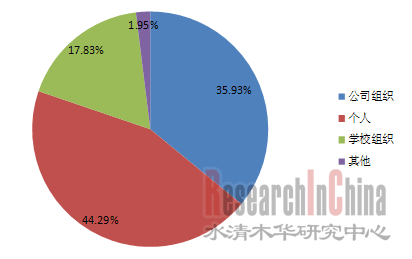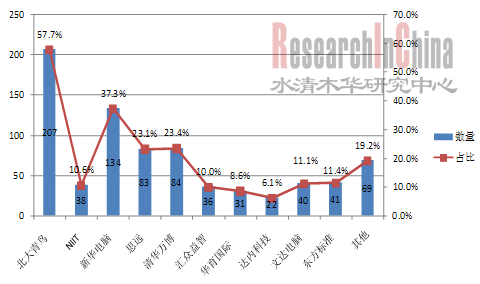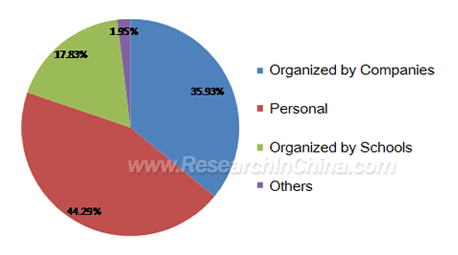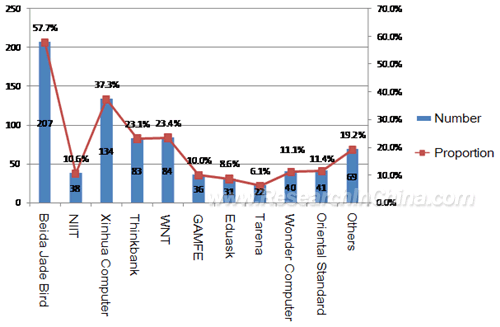2010年8月,水清木华研究中心和第一调查网合作对中国大陆市场600位用户进行了IT教育培训行业消费特征调查。调查内容包括:参加培训目的、参加培训方式、选择培训课程类型、课程设置偏好、培训费用投入、获取IT培训信息、消费者不参加IT培训原因、选择IT培训机构或考虑因素、消费者对参加过IT培训机构满意程度、参加IT培训对获得认证暨提高工作能力影响等。
在参加IT 培训方式的调查中,结果显示个人出资与公司组织是当前IT培训的两大方式。个人出资方式占44.29%,以公司组织的形式占35.93%。
图:消费者参加IT培训方式的调查结果 
来源:水清木华研究中心,第一调查网
在选择培训机构的调查(多选)中,结果显示北大青鸟的选择率最高,占57.7%;其次是新华电脑学校,占37.3%;再次是清华万博和思远。
图:消费者选择培训机构情况的调查结果 
来源:水清木华研究中心,第一调查网
本报告研究发现,未来中国IT教育和培训行业的发展重点如下:
1)注重提升就业推荐能力。
2)课程标准化是保证培训质量的重要组成部分。IT培训的课程标准化,除了要求整个体系使用统一的培训教材、课件之外,在教学方法、教师队伍建设、讲课内容、每节课内容的详细时间安排等方面,都要求做到有统一的标准和规范。
3)“实训机制”应该更加普及和完善。实训就是让学员在真实的企业开发环境里亲自动手,开发采编来自软件企业的实际项目,接受规范化的软件开发过程的管理和全方位的企业员工素质训练。这种基于实际项目的训练区别于传统IT培训的案例式教学,学员毕业后,可直接进入软件企业就职。
In August 2010, ResearchInChina cooperated with 1diaocha.com to conduct a
online survey on 600 interviewees in Chinese IT education and training
industry, which covered the followings: purposes of consumers for IT
training, ways for them to participate IT training, the types of
curriculum they select, preference for course design, training costs,
how they get the information about IT training, why consumers do not
participate in IT training, considerations of consumers for choice of IT
training institutions, satisfaction of consumers with IT training
institutions in which they participated, how IT training impacts on them
(such as certification and work ability).
The survey shows that
44.29% of consumers participate in IT training on their own expenditure,
while 35.93% of consumers are arranged by their companies to
participate.
Survey on How Consumers Participate IT Training 
Source: ResearchInChina; www.1diaocha.com
As
for training institutions,57.7% of consumers prefer Beida Jade Bird,
37.3% like Xinhua Computer Education, followed by WNT and Thinkbank IT
Academy.
IT Training Institutions Chosen by Consumers 
Source: ResearchInChina; www.1diaocha.com
In the future, the development focus of IT education & training industry in China can be shown as follow:
1) Focus on Employment and Enhance Recommendation of Students to Companies.
2)
Curriculum standardization is a key factor that guarantees the quality
of training. Apart from the requirements on the standardized training
materials and courseware, curriculum standardization of IT training also
calls for uniform standards and norms for teaching methods, teaching
staff construction, lectures and class schedule.
3) Promote and
improve the "internship system". Students enter real enterprises to
work, involve in actual projects of software companies, accept the
management of standardized software development process, and take part
in comprehensive training for employees. "Internship system" is
distinguished from traditional IT case training, and students can be
directly employed by the software companies after graduation.